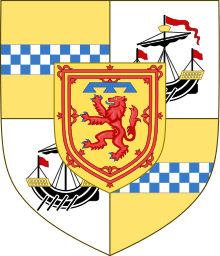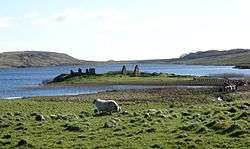Lord of the Isles
The Lord of the Isles (Scottish Gaelic: Triath nan Eilean or Rìgh Innse Gall) is a title of Scottish nobility with historical roots that go back beyond the Kingdom of Scotland. It emerged from a series of hybrid Norse Gaels rulers of the isle of Man and west coast and islands of Scotland in the Middle Ages, who wielded sea-power with fleets of galleys (birlinns). Although they were, at times, nominal vassals of the Kings of Norway, Ireland, or Scotland, the island chiefs remained functionally independent for many centuries. Their territory included the Isle of Man, Hebrides (Skye and Ross from 1438), Knoydart, Ardnamurchan, and the Kintyre peninsula. At their height they were the greatest landowners and most powerful lords in Britain after the Kings of England and Scotland.[1]
| Lordship of the Isles | |
|---|---|
 Arms of Prince Charles, as used in Scotland. The galley in the 2nd and 3rd quarters represents the Lordship of the Isles | |
| Creation date | c. 875 |
| Present holder | Charles |
| Heir apparent | William |


The end of the MacDonald Lords came in 1493 when John MacDonald II had his ancestral homeland, estates, and titles seized by King James IV of Scotland. Since that time, the MacDonald Clan has contested the right of James IV to the Lordship of the Isles and uprisings and rebellions against the Scottish Monarch were common. More recently, the Lordship of the Isles has been held by the Duke of Rothesay, the eldest son and heir apparent of the King of Scotland, a title which, since the creation of the Kingdom of Great Britain, is usually borne by the Prince of Wales. Thus Prince Charles is the current Lord of the Isles.
Finlaggan on Islay was the seat of the Lords of the Isles under Clan Donald.[2]
Armorials
The arms adopted by the Lord of the Isles varied over time, but the blazon given and illustrated[3] in "The Armorial of Sir David Lyndsay of the Mount" (1542) is: Or, an eagle displayed Gules beaked and membered Sable, surmounted by a galley also Sable.
Background
.png)
The west coast and islands of present-day Scotland were those of a people or peoples of uncertain cultural affiliation until the 5th century. They were invaded by Gaels from Ireland starting perhaps in the 4th century or earlier, whose language eventually predominated. In the 8th and 9th centuries this area, like others, suffered raids and invasions by Vikings from Norway, and the islands became known to the Gaels as Innse-Gall, the Islands of the Foreigners. Around 875, Norwegian jarls, or princes, came to these islands to avoid losing their independence in the course of King Harald Fairhair's unification of Norway, but Harald pursued them and conquered the Hebrides as well as Man, and the Shetland and Orkney Islands. The following year, the people of the Isles, both Gael and Norse, rebelled. Harald sent his cousin Ketill Flatnose to regain control, and Ketil then became King of the Isles. Scotland and Norway would continue to dispute overlordship of the area, with the jarls of Orkney at times seeing themselves as independent rulers.
In 973, Maccus mac Arailt, King of the Isles, Kenneth III, King of the Scots, and Máel Coluim I of Strathclyde formed a defensive alliance, but subsequently the Scandinavians defeated Gilla Adomnáin of the Isles and expelled him to Ireland. The Norse nobleman Godred Crovan became ruler of Man and the Isles, but he was deposed in 1095 by the new King of Norway, Magnus Bareleg. In 1098, Magnus entered into a treaty with King Edgar of Scotland, intended as a demarcation of their respective areas of authority. Magnus was confirmed in control of the Isles and Edgar of the mainland. Lavery cites a tale from the Orkneyinga saga, according to which King Malcolm III of Scotland offered Earl Magnus of Orkney all the islands off the west coast navigable with the rudder set. Magnus then allegedly had a skiff hauled across the neck of land at Tarbert, Loch Fyne with himself at the helm, thus including the Kintyre peninsula in the Isles' sphere of influence. (The date given falls after the end of Malcolm's reign in 1093.)
Founding of the dynasties
Somerled, Gilledomman's grandson, seized the Isles (i.e. everything except the Isle of Man & Skye) from the King of Man in 1156 and founded a dynasty that in time became the Lords of the Isles. He had Celtic blood on his father's side and Norse on his mother's: his contemporaries knew him as Somerled Macgilbred, Somhairle or in Norse Sumarlidi Höld ('Somerled' means "summer wanderer", the name given to the Vikings). He took the title Rí Innse Gall (King of the Hebrides) as well as King of Mann.
After Somerled's death in 1164, three of his sons, and his brother-in-law (the King of Man), divided his realm between them:
- The King of Man : Man, Lewis, Harris, and Skye
- The sons of Somerled :
- Angus : unclear area, perhaps the remaining northern regions
- Dougall (ancestor of Clan MacDougall) : Morvern, Ardnamurchan, and Mull
- Ronald : unclear area, perhaps the southern regions
For reasons which are now unclear, Ronald's sons seem to have taken over the territory of both him and Angus, splitting it between them:
The MacDonald lordship
.jpg)
In their maritime domain the Lords of the Isles used galleys (birlinns) for both warfare and transport. These ships had developed from the Viking longships and knarrs, clinker-built with a square sail and rows of oars. From the 14th century they changed from using a steering oar to a stern rudder. These ships took part in sea battles and attacked castles or forts built close to the sea. The Lordship specified the feudal dues of its subjects in terms of numbers and sizes of the galleys (birlinns) each area had to provide in service to their Lord.
List of MacDonald Lords of the Isles
- John of Islay I, Lord of the Isles
- Domhnall of Islay, Lord of the Isles
- Alexander of Islay, Earl of Ross and Lord of the Isles
- John of Islay II, Earl of Ross and Lord of the Isles
- Angus Óg
Council of the Isles

The Lord was advised (at least on an occasional basis) by a Council. Dean Monro of the Isles, who wrote a description of the Western Isles in 1549, described the membership as consisting of four ranks:
- Four "great men of the royal blood of Clan Donald lineally descended" (Macdonald of Clanranald, Macdonald of Dunnyvaig, MacIain of Ardnamurchan and Macdonald of Keppoch)
- Four "greatest of the nobles, called lords" (Maclean of Duart, Maclaine of Lochbuie, Macleod of Dunvegan and Macleod of the Lewes)
- Four "thanes of less living and estate" (Mackinnon of Strath, MacNeil of Barra, MacNeill of Gigha and Macquarrie of Ulva)
- "Freeholders or men that had their lands in factory" (Mackay of the Rhinns, MacNicol of Scorrybreac, MacEacharn of Kilellan, Mackay of Ugadale, Macgillivray in Mull and Macmillan of Knapdale).[4]
In practice, membership and attendance must have varied with the times and the occasion. A commission granted in July 1545 by Domhnall Dubh, claimant to the Lordship, identified the following members:
- Hector Maclean of Duart
- John Macdonald of Clanranald
- Ruari Macleod of the Lewes
- Alexander Macleod of Dunvegan
- Murdoch Maclaine of Lochbuie
- Allan Maclean of Torloisk
- Archibald Macdonald, Captain of Clann Uisdein
- Alexander MacIan of Ardnamurchan
- John Maclean of Coll
- Gilleonan MacNeil of Barra
- Ewen Mackinnon of Strath
- John MacQuarrie of Ulva
- John Maclean of Ardgour
- Alexander Macdonell of Glengarry
- Angus Macdonald of Knoydart
- Donald Maclean of Kingairloch
- Angus Macdonald, brother of James Macdonald of Dunnyveg.[5]
End of the MacDonald lordship
Successive Lords of the Isles fiercely asserted their independence from Scotland, acting as kings of their territories well into the 15th century. Then in 1462, John MacDonald II Lord of the Isles signed a treaty with Edward IV of England to conquer Scotland with him and the Earl of Douglas. The treaty between Edward IV and John II has been used to show how the MacDonald Lords were viewed as independent rulers of their kingdom, freely entering into national and military treaties with foreign governments. Unfortunately for the MacDonald sovereigns, the civil war in England, known as the Wars of the Roses, prevented the completion of the alliance between Edward IV and John II. Upon the discovery of his alliance with Edward IV in 1493, John II had his ancestral lands, estates, and titles taken from him by James IV of Scotland. In addition to James IV seeking revenge on John II, he possessed a larger military force and was able to impose his will on the West Coast of Scotland, though uprisings and rebellions were common. Though the Lordship was taken away from the MacDonald family in the 15th century, waves of successive MacDonald leaders have contested this and fought for its revival ever since, notably during Dubh's Rebellion. Since then, the eldest male child of the reigning Scottish (and later, British) monarch has been styled "Lord of the Isles", essentially merging the crowns of Dal Riada with the Pictish East of Scotland. The office itself has been extinct since the 15th century and the style since then has no other meaning but to recall the Scottish seizure of the ancient Norse-Gaelic lordship and crown. Currently Prince Charles is titular Lord of the Isles, as well as Duke of Rothesay, Earl of Carrick, Baron of Renfrew and High Steward of Scotland.
Footnotes
- At their height the Lords of the Isles were thus of comparable power to the Geraldines or perhaps even the O'Neill dynasty of Late Medieval Ireland.
- "Finlaggan, Islay: The Centre of the Lords of the Isles". Finlaggan Trust. 2015. Retrieved 1 May 2018.
- "Heraldry".
- R.W.Munro (ed), Monro's Western Islands of Scotland & Genealogies of the Clans (Edinburgh 1961)
- Donald Gregory, History of the Western Highlands and Isles of Scotland from AD 1493 to AD 1625 (William Tait, Edinburgh, 1836), at page 170
References
- Bannerman, J., The Lordship of the Isles, in Scottish Society in the Fifteenth Century, ed. J. M. Brown, 1977.
- Brown M, James I, 1994.
- Dunbar, J., The Lordship of the Isles, in The Middle Ages in the Highlands, Inverness Field Club, 1981 ISBN 978-0-9502612-1-8.
- Gregory, D., History of the Western Highlands and Islands of Scotland, 1975 reprint.
- MacDonald, C. M., The History of Argyll, 1950.
- McDonald, R. A., The Kingdom of the Isles: Scotland's Western Seaboard, 1100–c1336, 1997.
- Munro. J., The Earldom of Ross and the Lordship of the Isles, in Firthlands of Ross and Sutherland, ed. J. R. Baldwin, 1986.

.svg.png)